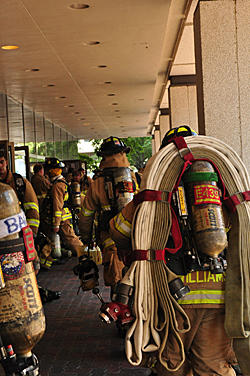
Firefighters respond to fire in 13-story high rise.
When responding to fires in high-rise buildings, firefighting crews of five or six members—instead of three or four—are significantly faster in putting out fires and completing search-and-rescue operations, according to a major new study carried out by the National Institute of Standards and Technology (NIST) in cooperation with five other organizations.
"Unlike most house fires, high-rise fires are high-hazard situations that pose unique operational challenges to fire service response. How big a fire gets and how much danger it poses to occupants and firefighters is largely determined by crew size and how personnel are deployed at the scene," says Jason Averill, a NIST fire protection engineer. "It's not simply that larger crews have more people. Larger crews are deployed differently and, as a result, are able to perform required tasks more quickly."
The NIST study, conducted with 13 Washington, D.C.-area fire departments, analyzed 14 "critical tasks"—those undertaken when potential risks to building occupants and firefighters are greatest—found that three-member crews took almost 12 minutes longer than crews of four, 21 minutes longer than crews of five, and 23 minutes longer than crews of six to complete all tasks. Four-person crews took nine minutes and 11 minutes longer than five- and six-member crews, respectively.
The study also looked at the effect of using fire service access elevators to move firefighters and equipment up to the staging floor and concluded that most tasks were started two to four minutes faster when using the elevators compared with using the stairs. The research was conducted in a vacant, 13-story office building in Crystal City, Va., and involved 48 separate controlled experiments, plus 48 corresponding computer-modeling simulations, which evaluated three types of representative fires, from slow to fast growing.
"This study will result in better-informed policy and operational decisions influencing levels of staffing and other resources available for responding to high-rise fires," says Dennis Compton, former chief of the Mesa, Ariz., fire department and chairman of the board of the National Fallen Firefighter Foundation. "These are decisions now confronting hundreds of communities across the country."
On the basis of the results of computer modeling, which incorporate data from live experimental burns, the study team concluded that smaller crews end up facing larger fires because of the additional time required to complete tasks. Comparing the performances of different-sized crews, the researchers found that adding two members to three- and four-person teams would result in the largest improvements in starting and completing critical tasks, such as advancing the water hose to the fire location and beginning search and rescue. Improvements ranged from one minute to 25 minutes, depending on the task.
The research team also evaluated whether dispatching more three or four-member crews to a high-rise fire—accomplished by sounding a higher initial alarm—would be as effective as sending a low first alarm contingent of engines and trucks staffed by more firefighters. They found that a "low-alarm response with crews of size four or five outperforms a high-alarm response with crew sizes smaller by one firefighter."
While much less frequent than house fires, about 43 high-rise fires occur in the United States every day. Between 2005 and 2009, according to the National Fire Protection Association (NFPA), high-rise structure fires averaged 15,700 annually. Average annual losses totaled 53 civilian deaths, 546 civilian injuries and $235 million in property damage.
The new study on responding to high-rise fires complements a 2010 study from the same research team that looked at staffing levels and arrival times in the context of fighting residential fires.*
For more details on the research and conclusions, read the full April 10, 2013, story, "Landmark High-Rise Fire Study Evaluates Effectiveness of Crew Sizes, Elevator Use."
The study was funded by the Federal Emergency Management Agency (FEMA) Assistance to Firefighters Grants Program.
*See the May 11, 2010, NIST Tech Beat story "Landmark Study Shows How Size of Fire Crew Influences Saving Lives and Property."

